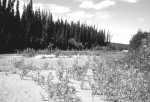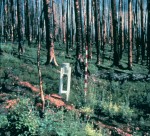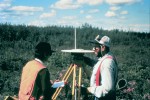The boreal forest plays a critical role in determining the rate of global climate change because:
- Changes in water and energy exchange could affect regional warming
- Changes in carbon storage might affect the rate of climatic warming at the global scale
In the future, Bonanza Creek Long-Term Ecological Research Program seeks to understand the Alaskan boreal forest as an integrated regional system in which climate, disturbance regime, and ecosystem processes are interactive components. Our overall objective is to document the major controls over these interactions and their ecological and societal consequences. We incorporate disturbance as an integral component of our regional system and study how different disturbances affect population and ecosystem processes and the mechanisms by which these processes interact with climate to determine probability of insect outbreak and fire.
Climate
Climate research at the Bonanza Creek LTER (BNZ) has focused on describing
- The regional patterns of climate for Alaska
- The patterns of seasonal and interannual variability in climate at BNZ
- The changes in microclimate caused by topography and vegetation succession
We summarized climate data for the entire state and used a krieging routine to produce maps of monthly temperature, precipitation, and climate zones for Alaska. Contours of mean annual temperature show a general northward movement of the 0°C isolines from the 1960s to the 1980s, indicating a warming trend throughout Alaska.
Recent warming has caused the active layer and permafrost surface temperatures to increase by 1-2°C, so that annual temperatures at the ground surface and in the upper active layer exceed the freezing point. Permafrost remains stable at some sites only because of the insulative effects of moss and a thick layer of organic soil, but is thawing at other sites, creating thermokarst.
Environmental monitoring showed that precipitation affects soil moisture in the uplands most strongly in mid-successional deciduous forests. In floodplain stands, soil moisture is controlled by river discharge rates and successional changes in terrace height. Extreme climatic events have had greater impact on stand mortality and structure than have annual fluctuations in climate. These include the record-breaking snowfall of 1990-1991 that reduced tree biomass in conifer stands by as much as 50%, the early snowfall in 1992 that preceded leaf senescence and caused extensive tree mortality in deciduous stands, and the lack of snow during the early winter of 1995-1996 which significantly reduced soil temperatures.
Disturbance Regime
We have used permanent plots to demonstrate the impacts of disturbance on the structure, composition, establishment, and mortality of forests and have used historical records and tree-ring chronologies to extend our observations back in time. These data become the basis of models that were initially largely conceptual and which now operate only at large temporal and spatial scales.
Fire is the major disturbance in central Alaska between the Alaska and the Brooks Ranges. Vegetation distribution and fire scar analysis at BNZ suggest a fire return interval of 70 to 110 years. Maps of lightning strikes are a good predictor of fire frequency, but the area burned is influenced more strongly by climate and vegetation.
Insect outbreaks are extensive only in more continental regions of southern Alaska, where climate is relatively warm. Here insects have eliminated spruce forests over broad areas, leading to extensive areas of grasslands. High population levels of spruce budworm were first observed in BNZ in 1989. Repeated defoliation in 1991 and 1992 caused top-kill in trees and mortality in seedlings and saplings. Outbreaks of bark beetles also caused significant mortality in 1993. We are extending these records back in time based on distinctive signatures in tree rings.
The heavy sediment load of the glacier-fed Tanana River supports an aggrading system where silt deposition associated with floods builds terraces of increasing height on the active floodplain.
Population Processes and Successional Dynamics
To test hypotheses about ecosystem controls in forest succession, we monitor a network of 27 sites at BNZ (3 replicates of 3 successional stages in the uplands and 6 on the floodplains—including a recently established time zero stage). These "turning points" in the two successional sequences were selected to document rapid vegetation changes that dramatically alter microclimate and ecosystem processes. We have thus directly observed transitions from one stage to the next in early succession, validating the "space-for-time" assumption that underlies our chronosequence. This design also enables us to contrast vegetation composition and structure across a floodplain and upland chronosequence. Repeated measurement of permanent plots allows us to document changes in composition and diversity that correlate with the satellite record of vegetation change. Species diversity is closely tied to disturbance regime, with hot spots of insect and bird diversity in early successional floodplain stands and nonvascular diversity increasing in late successional spruce forests.
Selective browsing by moose and hares modulates the competitive interactions of pioneer species and accelerates the rate of successional change. Herbivores feed preferentially on pioneer willows, leading to the competitive release of mid-successional species such as alder and poplar. The severe negative effects of browsing on growth and reproduction are an important component of this shift in species dominance. Moreover, browsing-induced changes in canopy architecture has cascading effects on nutrient cycling through changes in physical environment, litter chemistry, and the proportion of nutrients returned as feces.
Pattern and Control of Primary Production
We have measured interannual variation in litterfall and tree diameter increment relative to climate in all the major forest successional types and manipulated the factors thought to control forest production in upland and floodplain successional forests (moisture, microbial energy supply, and N supply). The initial stimulation of microbial respiration and N immobilization following C addition, with resulting changes in tree foliar chemistry, largely disappeared by year three, whereas reduced moisture supply strongly reduced tree transpiration and production, and N addition stimulated N mineralization and production.
Biogeochemical Processes
Experimental treatments (addition of N, sawdust and sugar, moisture reduction) caused significant differences in successional patterns of foliar chemistry between upland and floodplain forests. While both upland and floodplain successional sequences showed similar reductions in foliar N concentration though time, the decline in P concentration was more dramatic in upland stands. Upland vegetation showed clear increases in lignin:nitrogen, lignin:phosphorus, and cellulose:lignin ratios through succession, but successional trends in floodplain stands were less clear. Successional trends in litter chemistry paralleled foliage chemistry.
Alaskan interior forests have rates of fine root production and turnover that are similar to those in temperate forests, despite significantly less aboveground production. This higher proportion of total ecosystem C allocated below ground in boreal forests contributes to large soil C stocks, with most soil respiratory fluxes being derived from the rapid turnover of fine roots rather than from heterotrophic respiration. Approximately three times more N is cycled through fine roots than through aboveground litterfall.
In LTER2 we developed working models of high-latitude cold-dominated watersheds and aquatic ecosystems that summarize existing knowledge and provide structure for future work. Much of interior Alaska is in the zone of discontinuous permafrost, in which south-facing slopes are generally permafrost-free, and cold north-facing slopes and poorly drained valley bottoms are generally underlain by permafrost. Permafrost is a major "ecological adjective" modifying hydrology, thermal regimes, chemical fluxes from uplands to streams, and biotic processes in streams. Therefore, permafrost occupies a central role in our models and has been the focus of our recent research, comparing the hydrology, biogeochemistry, and benthic ecology of permafrost-dominated and permafrost-free watersheds at Caribou-Poker Creeks Research Watershed (CPCRW).
Extension of LTER Results to the Regional Scale
We have parameterized the models LINKAGES, FORCYTE-10, and CENTURY based partially on data collected in the BNZ LTER project. The CENTURY model effectively simulated the observed results of C and N fertilization, providing a basis for modeling biogeochemical cycling at BNZ. Sensitivity analyses with these models highlighted the importance of:
- Root dynamics in C-budget models
- The effect of the vegetation canopy (specifically trees and moss) on soil temperature regime
- The difficulty of extrapolating processes from intensive sites to the North American boreal forest
- The importance of precipitation in predicting future forest productivity in global change analysis
In addition we have worked with the EROS data center to develop maps of climatic and ecosystem parameters that will be essential for modeling in LTER3.
We have supported a variety of studies to evaluate the utility of airborne and satellite remote sensing data for extrapolating our understanding of ecosystem processes from BNZ over broader spatial and temporal scales. The GIS programs developed in LTER2 were initially applied to small-scale experiments that manipulated spruce and alder densities, where exact locations and sizes of trees were known. Three data sets at different scales were prepared to test for bias in detecting vegetation change at scales ranging from plot photographs to 30-meter satellite imagery of Bonanza Creek to 1-km AVHRR imagery of Alaska. These data sets demonstrate the significance of bias and correct satellite-based estimates of vegetation change. Satellite images are also being used to test for differences in spectral leaf area index associated with soil type and topography.
Synthesis and Integration
In summary, we have documented significant climatic changes since the initiation of our LTER research, including warmer air and soil temperatures, and drought that is unprecedented in the past 200 years. These trends correlate with increased frequency of thermokarst (melting of ice-rich permafrost), fire, insect outbreaks (southern Alaska), reduced growth and seed production in white spruce, the late-successional dominant tree, and extensive grassland development following large-scale disturbances. These changes suggest directional changes in structure and function of the Alaskan boreal forest. However, within stands, the microclimate, stand structure, productivity, and biogeochemistry have been influenced more strongly by extreme events such as snow breakage and by successional changes in browsing and vegetation than by broad climatic trends. In LTER3 our studies will be broadened to the landscape level, using observations, GIS, and modeling to integrate these two scales Population and biogeochemical processes are inextricably intertwined in the Alaskan boreal forest. Animal diversity and impact are greatest in early succession, where they respond to, and affect, the rates and patterns of plant succession, root allocation, and biogeochemistry. The associated changes in species composition from willow to alder to poplar to spruce during floodplain succession cause changes in nitrogen inputs, N mineralization and nitrification rates, microbial immobilization, and the degree of N limitation to primary production. The changing soil environment, due to both plant and animal impacts, alters microbial community composition, which determines methane oxidation rate.
At larger scales, the effects of climate on insects and fire influence the size and frequency of disturbance and the competitive interactions between spruce and grass during early colonization. These interactions may be influenced by herbivores and pathogens sufficiently to influence the trajectory and rate of succession. The structure of the terrestrial ecosystems in turn is the primary determinant of the chemistry and community composition of streams and lakes. In LTER3 we will explore the factors influencing these interactions between population, biogeochemical and landscape processes.

 Enlarge this image
Enlarge this image


